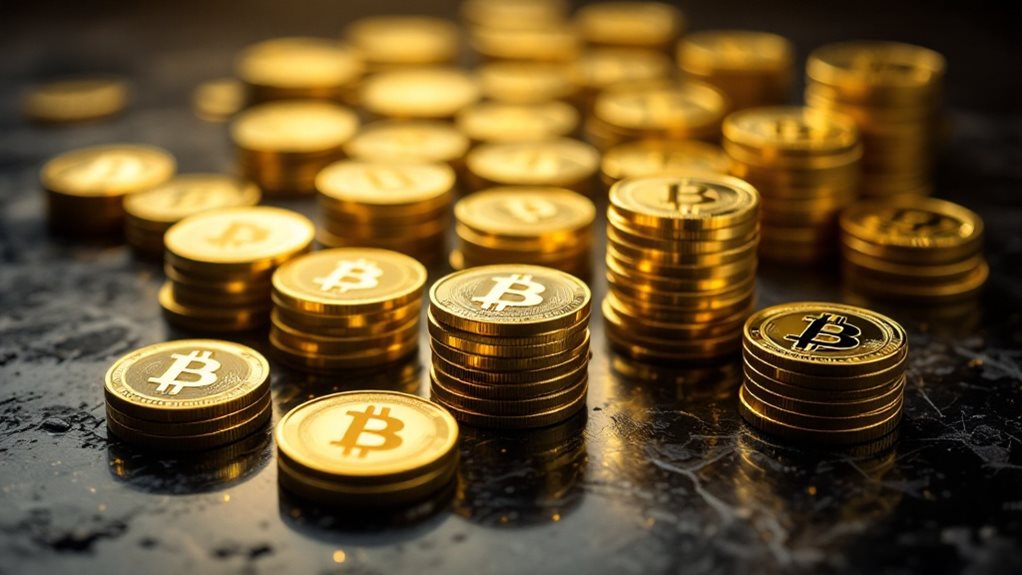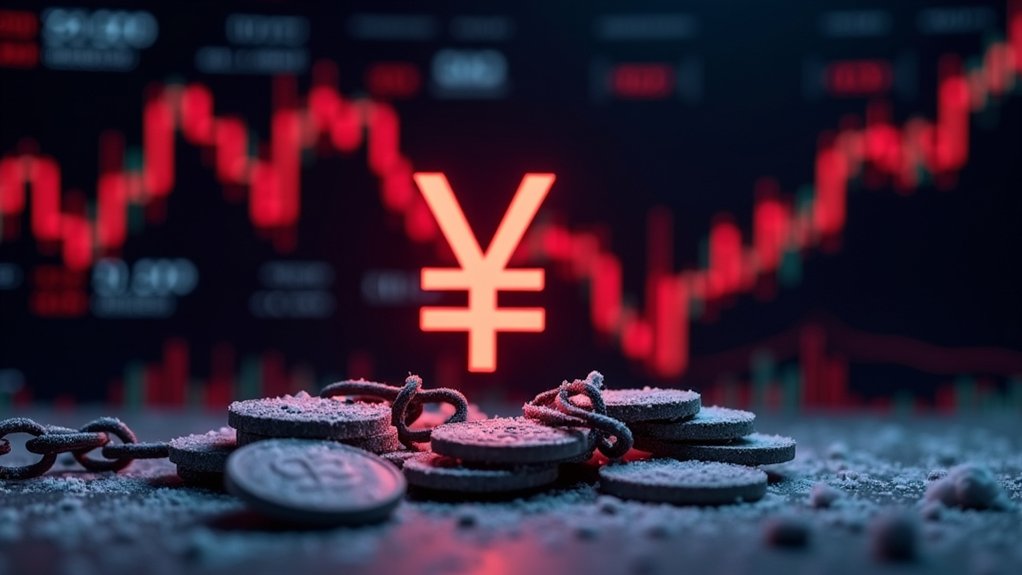Bitcoin’s current circulation stands at over 19.5 million coins, which is more than 80% of its maximum limit of 21 million. About 900 new bitcoins are created daily through mining, though some coins have been permanently lost over time. The system was designed by Satoshi Nakamoto with a hard cap to prevent inflation, unlike traditional currencies that can be printed endlessly. There’s much more to understand about Bitcoin’s unique supply management system.
Quick Overview
- Currently, over 19.5 million bitcoins are in worldwide circulation, representing more than 80% of the maximum supply limit.
- Approximately 900 new bitcoins are mined and added to circulation daily through the mining process.
- The actual usable circulation is lower than 19.5 million because up to 20% of mined bitcoins are permanently lost.
- New bitcoins enter circulation every 10 minutes when miners successfully add blocks, currently receiving 6.25 bitcoins per block.
- Bitcoin’s circulation will never exceed 21 million coins, with the final bitcoin expected to be mined around 2140.

More than 19.5 million bitcoins are currently circulating worldwide, representing over 80% of the cryptocurrency’s maximum supply of 21 million coins. This circulating amount keeps growing daily as new bitcoins are created through a process called mining. As of 2024, roughly 900 new bitcoins enter circulation each day, though the actual usable amount is lower because some bitcoins have been permanently lost or become inaccessible over time.
Bitcoin’s creator, Satoshi Nakamoto, programmed a strict limit of 21 million coins into the Bitcoin protocol. This hard cap wasn’t chosen randomly – it was designed to create scarcity and prevent inflation of the digital currency. Based on Bitcoin’s programming, the last bitcoin won’t be mined until around the year 2140, though the exact total might fall slightly short of 21 million due to rounding in the code.
The creation of new bitcoins follows a predictable schedule through the mining process. Currently, miners receive 6.25 bitcoins as a reward for each new block they add to the blockchain, which happens approximately every 10 minutes. This reward gets cut in half every 210,000 blocks, or roughly every four years, in an event known as the “halving.” The next halving is scheduled for 2024, when the reward will decrease to 3.125 bitcoins per block. Research suggests that up to 20% of all mined bitcoins may be permanently inaccessible due to lost private keys or death of wallet owners.
The limited supply of Bitcoin plays a significant role in its economic model. As fewer new bitcoins are created over time, the increasing scarcity could potentially impact their value. This design feature stands in contrast to traditional currencies, which can be printed in unlimited quantities by governments. The decreasing block rewards also affect Bitcoin miners, who’ll need to rely more on transaction fees as their mining rewards diminish. After 2140, miners will earn income solely through transaction fees when the maximum supply is reached.
The way Bitcoin manages its supply is unique in the financial world. While traditional currencies can be printed as needed, Bitcoin’s supply is mathematically certain and transparent. Anyone can verify how many bitcoins exist at any time, and the schedule for future bitcoin creation is set in stone.
This predictability helps users understand exactly how many bitcoins exist now and how many will exist in the future, making it different from traditional money systems where supply changes can be less predictable and harder to track.
Frequently Asked Questions
What Happens to Lost or Permanently Inaccessible Bitcoins?
Lost bitcoins remain permanently on the blockchain but can’t be accessed or used.
They’re like money locked in a safe without the combination – it still exists but nobody can spend it.
When bitcoins become inaccessible, they effectively reduce Bitcoin’s total supply, making the remaining coins potentially more valuable.
While the coins aren’t destroyed, they’re frozen forever in digital wallets that no one can open.
Can Bitcoin’s Maximum Supply of 21 Million Ever Be Changed?
While it’s technically possible to change Bitcoin’s 21 million supply cap, it’s extremely unlikely to happen.
It would require widespread agreement from developers, miners, and network participants worldwide. Such a change would need a hard fork, creating a separate version of Bitcoin.
The original network with the 21 million cap would continue to exist. Most importantly, changing the cap would go against Bitcoin’s core principle of scarcity.
How Does Bitcoin Halving Affect the Rate of New Coins?
Bitcoin halving cuts the number of new coins created in half every four years.
It’s like turning down a faucet to reduce water flow.
Before the April 2024 halving, miners got 6.25 bitcoins for each block they mined.
Now they get 3.125 bitcoins.
This means fewer new bitcoins enter circulation at a slower rate.
The process repeats until 2140 when no more new bitcoins will be created.
Why Did Satoshi Nakamoto Choose 21 Million as the Maximum Supply?
While Satoshi Nakamoto never explicitly explained the choice of 21 million bitcoins, it’s believed to be a combination of technical and economic factors.
The number works well with Bitcoin’s code structure, particularly with halving schedules and block rewards.
It’s also thought that Nakamoto wanted a number that’d be scarce enough to create value but large enough to handle global transactions.
The 21 million cap helps prevent inflation by limiting supply.
How Many Bitcoins Are Held by Major Cryptocurrency Exchanges?
Major crypto exchanges hold a significant portion of Bitcoin. Binance leads with over 500,000 BTC, followed by Coinbase with about 450,000 BTC.
Bitfinex comes in third with around 200,000 BTC, while Kraken has roughly 150,000 BTC. Gemini rounds out the top five with about 125,000 BTC.
Together, these major exchanges control approximately 7% of all Bitcoin.
Exchange balances have been declining since 2020 as more people move their coins elsewhere.





